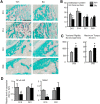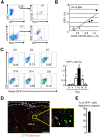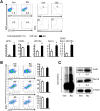Proteasome inhibition-enhanced fracture repair is associated with increased mesenchymal progenitor cells in mice
- PMID: 35213543
- PMCID: PMC8880819
- DOI: 10.1371/journal.pone.0263839
Proteasome inhibition-enhanced fracture repair is associated with increased mesenchymal progenitor cells in mice
Abstract
The ubiquitin/proteasome system controls the stability of Runx2 and JunB, proteins essential for differentiation of mesenchymal progenitor/stem cells (MPCs) to osteoblasts. Local administration of proteasome inhibitor enhances bone fracture healing by accelerating endochondral ossification. However, if a short-term administration of proteasome inhibitor enhances fracture repair and potential mechanisms involved have yet to be exploited. We hypothesize that injury activates the ubiquitin/proteasome system in callus, leading to elevated protein ubiquitination and degradation, decreased MPCs, and impaired fracture healing, which can be prevented by a short-term of proteasome inhibition. We used a tibial fracture model in Nestin-GFP reporter mice, in which a subgroup of MPCs are labeled by Nestin-GFP, to test our hypothesis. We found increased expression of ubiquitin E3 ligases and ubiquitinated proteins in callus tissues at the early phase of fracture repair. Proteasome inhibitor Bortezomib, given soon after fracture, enhanced fracture repair, which is accompanied by increased callus Nestin-GFP+ cells and their proliferation, and the expression of osteoblast-associated genes and Runx2 and JunB proteins. Thus, early treatment of fractures with Bortezomib could enhance the fracture repair by increasing the number and proliferation of MPCs.
Conflict of interest statement
NO authors have competing interests.
Figures








Similar articles
-
Ubiquitin e3 ligase itch negatively regulates osteoblast differentiation from mesenchymal progenitor cells.Stem Cells. 2013 Aug;31(8):1574-83. doi: 10.1002/stem.1395. Stem Cells. 2013. PMID: 23606569 Free PMC article.
-
TGF-β inhibits osteogenesis by upregulating the expression of ubiquitin ligase SMURF1 via MAPK-ERK signaling.J Cell Physiol. 2018 Jan;233(1):596-606. doi: 10.1002/jcp.25920. Epub 2017 Jun 5. J Cell Physiol. 2018. PMID: 28322449
-
Apigenin manipulates the ubiquitin-proteasome system to rescue estrogen receptor-β from degradation and induce apoptosis in prostate cancer cells.Eur J Nutr. 2015 Dec;54(8):1255-67. doi: 10.1007/s00394-014-0803-z. Epub 2014 Nov 19. Eur J Nutr. 2015. PMID: 25408199
-
Overview of proteasome inhibitor-based anti-cancer therapies: perspective on bortezomib and second generation proteasome inhibitors versus future generation inhibitors of ubiquitin-proteasome system.Curr Cancer Drug Targets. 2014;14(6):517-36. doi: 10.2174/1568009614666140804154511. Curr Cancer Drug Targets. 2014. PMID: 25092212 Free PMC article. Review.
-
(Immuno)proteasomes as therapeutic target in acute leukemia.Cancer Metastasis Rev. 2017 Dec;36(4):599-615. doi: 10.1007/s10555-017-9699-4. Cancer Metastasis Rev. 2017. PMID: 29071527 Free PMC article. Review.
Cited by
-
Neuroprotective Effects of Nanowired Delivery of Cerebrolysin with Mesenchymal Stem Cells and Monoclonal Antibodies to Neuronal Nitric Oxide Synthase in Brain Pathology Following Alzheimer's Disease Exacerbated by Concussive Head Injury.Adv Neurobiol. 2023;32:139-192. doi: 10.1007/978-3-031-32997-5_4. Adv Neurobiol. 2023. PMID: 37480461 Review.
-
Atypical femoral fracture in a multiple myeloma patient undergoing treatment with denosumab: A case report and literature review.Int J Surg Case Rep. 2023 Jul;108:108456. doi: 10.1016/j.ijscr.2023.108456. Epub 2023 Jul 3. Int J Surg Case Rep. 2023. PMID: 37421768 Free PMC article.
References
-
- Curtis EM, van der Velde R, Moon RJ, van den Bergh JP, Geusens P, de Vries F, et al.. Epidemiology of fractures in the United Kingdom 1988–2012: Variation with age, sex, geography, ethnicity and socioeconomic status. Bone. 2016;87:19–26. Epub 2016/03/13. doi: 10.1016/j.bone.2016.03.006 . - DOI - PMC - PubMed
-
- Pountos I, Georgouli T, Henshaw K, Bird H, Jones E, Giannoudis PV. The effect of bone morphogenetic protein-2, bone morphogenetic protein-7, parathyroid hormone, and platelet-derived growth factor on the proliferation and osteogenic differentiation of mesenchymal stem cells derived from osteoporotic bone. J Orthop Trauma. 2010;24(9):552–6. Epub 2010/08/26. doi: 10.1097/BOT.0b013e3181efa8fe . - DOI - PubMed
Publication types
MeSH terms
Substances
Grants and funding
LinkOut - more resources
Full Text Sources
Medical
Molecular Biology Databases

